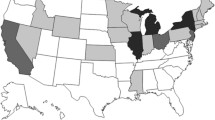Abstract
The purpose of this paper is to study the determinants of interstate migration in the United States from 1965–1970 when a new change in direction of migration has started, and to examine the flow creation or flow diversion that results from migration to some appealing regions. Several related variables have been selected and tested for gross interstate migration flows. The results show that overall both push and pull factors have not been important. People from higher income regions migrate more, and migrants tend to move to states with higher incomes and larger population. Distance was not found to act as a significant deterrence to migration, whereas population density of origin and destination was significant. Previous migration was found to have a very strong effect on migration. The results of the study also suggested that there has been a major change in the location of growth areas in the United States during 1955–1970.
The study of concurrent flow showed that the states of Texas, Louisiana, Mississippi, Alabama, Georgia, and Florida combined have positively influenced migratory flow between origin and destination states. Empirical results, however, also showed that California did not have flow creation or flow diversion effects on interstate migration.
Similar content being viewed by others
References
Crown WH (1991) Migration and regional economic growth: An origin-destination model. Econ Dev Q 5:45–59
Fields GS (1979) Place-to-place migration: Some new evidence. Rev Econ Statist 61:21–32
Glejser H, Dramais A (1969) A gravity model of interdependent equations to estimate flow creation and diversion. J Reg Sci0 9:439–449
Gordon P, Theobold P (1981) Migration and spatial development in the Republic of Mexico. J Dev Areas 15:239–251
Greenwood MJ (1969) An analysis of the determinants of geographic labor mobility in the United States. Rev Econ Statist 51:189–194
Greenwood MJ (1970) Lagged response in the decision to migrate. J Reg Sci 10:375–384
Greenwood MJ (1975) A simultaneous-equations model of urban growth and migration. J Am Statist Assoc 70:797–810
Greenwood MJ (1985) Human migration: Theory, models and empirical studies. J Reg Sci 25:521–544
Greenwood MJ, Ladman TR (1978) An economic analysis of migration in Mexico. Ann Reg Sci 22:16–31
Greenwood MJ, Sweetland D (1972) The determinants of migration between standard metropolitan statistical areas. Demography 9:665–681
Krumm RJ (1983) Regional labor markets and the household migration decision. J Reg Sci 23:361–376
Mead A (1982) A simultaneous equations model of migration and economic changes in nonmetropolitan areas. J Reg Sci 22:512–527
Mueller CF (1982) The economics of labor migration: A behavioral analysis. Academic Press, New York
Muth RF (1971) Migration: Chicken or egg. South Econ J 37:295–306
Navaratil J, Doyle JJ (1977) The socioeconomic determinants of migration and the level of aggregation. South Econ J 43:1547–1559
Nelson P (1959) Migration, real income and information. J Reg Sci 1:49–50
Olvey LD (1972) Regional Growth and inter-regional migration — Their pattern of interaction. Rev Reg Stud 2:139–163
Porell FW (1982) Intermetropolitan migration and quality of life. J Reg Sci 22:137–158
Richardson HW (1976) Grwoth pole spillover: The dynamic of backwash and spread. Reg Stud 10:1–9
Sternlieb G, Hughes JW (1977) New regional and metropolitan realities of America. J Am Inst Planners 43:227–241
Vining DR Jr, Kontuly T (1978) Population dispersal from major metropolitan regions. An international comparison. Int Reg Sci Rev 3:49–73
Walsh, BM (1974) Expectations, information and human migration: specifying an econometric model of Irish migration to Britain. J Reg Sci 14:107–120
Author information
Authors and Affiliations
Additional information
This research was supported partly through Organized Research Funds of The University of Texas at Arlington.
Rights and permissions
About this article
Cite this article
Anjomani, A., Hariri, V. Migration stock and the issue of competing and complementary flows in United States interstate migration. J Popul Econ 5, 87–100 (1992). https://doi.org/10.1007/BF00168269
Received:
Accepted:
Issue Date:
DOI: https://doi.org/10.1007/BF00168269




